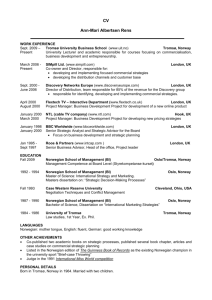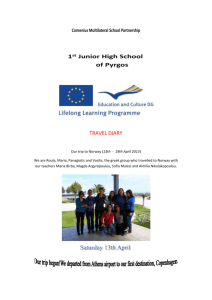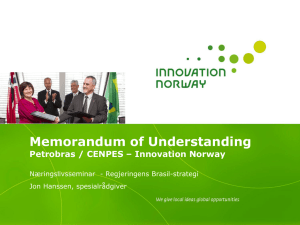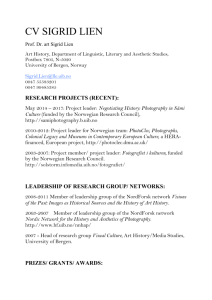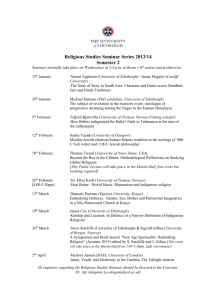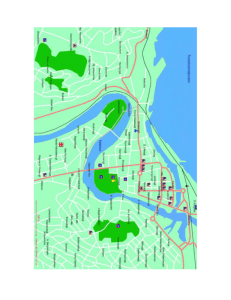entrepreneurship and capitalism - European Academy of the Regions
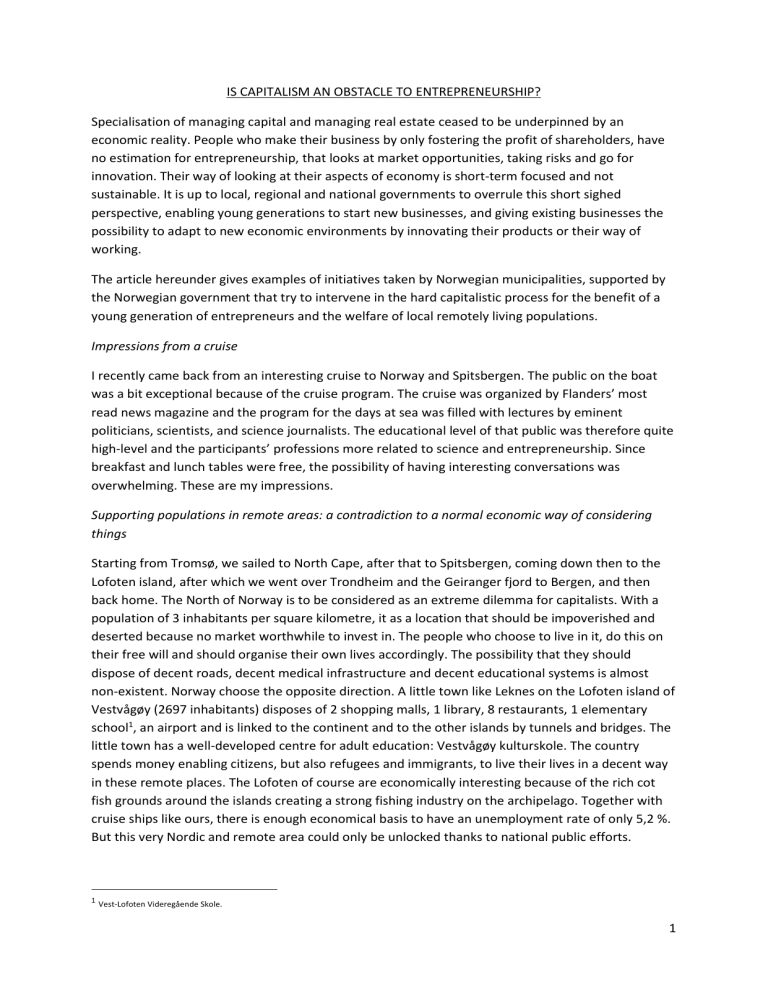
IS CAPITALISM AN OBSTACLE TO ENTREPRENEURSHIP?
Specialisation of managing capital and managing real estate ceased to be underpinned by an economic reality. People who make their business by only fostering the profit of shareholders, have no estimation for entrepreneurship, that looks at market opportunities, taking risks and go for innovation. Their way of looking at their aspects of economy is short-term focused and not sustainable. It is up to local, regional and national governments to overrule this short sighed perspective, enabling young generations to start new businesses, and giving existing businesses the possibility to adapt to new economic environments by innovating their products or their way of working.
The article hereunder gives examples of initiatives taken by Norwegian municipalities, supported by the Norwegian government that try to intervene in the hard capitalistic process for the benefit of a young generation of entrepreneurs and the welfare of local remotely living populations.
Impressions from a cruise
I recently came back from an interesting cruise to Norway and Spitsbergen. The public on the boat was a bit exceptional because of the cruise program. The cruise was organized by Flanders’ most read news magazine and the program for the days at sea was filled with lectures by eminent politicians, scientists, and science journalists. The educational level of that public was therefore quite high-level and the participants’ professions more related to science and entrepreneurship. Since breakfast and lunch tables were free, the possibility of having interesting conversations was overwhelming. These are my impressions.
Supporting populations in remote areas: a contradiction to a normal economic way of considering things
Starting from Tromsø, we sailed to North Cape, after that to Spitsbergen, coming down then to the
Lofoten island, after which we went over Trondheim and the Geiranger fjord to Bergen, and then back home. The North of Norway is to be considered as an extreme dilemma for capitalists. With a population of 3 inhabitants per square kilometre, it as a location that should be impoverished and deserted because no market worthwhile to invest in. The people who choose to live in it, do this on their free will and should organise their own lives accordingly. The possibility that they should dispose of decent roads, decent medical infrastructure and decent educational systems is almost non-existent. Norway choose the opposite direction. A little town like Leknes on the Lofoten island of
Vestvågøy (2697 inhabitants) disposes of 2 shopping malls, 1 library, 8 restaurants, 1 elementary school 1 , an airport and is linked to the continent and to the other islands by tunnels and bridges. The little town has a well-developed centre for adult education: Vestvågøy kulturskole. The country spends money enabling citizens, but also refugees and immigrants, to live their lives in a decent way in these remote places. The Lofoten of course are economically interesting because of the rich cot fish grounds around the islands creating a strong fishing industry on the archipelago. Together with cruise ships like ours, there is enough economical basis to have an unemployment rate of only 5,2 %.
But this very Nordic and remote area could only be unlocked thanks to national public efforts.
1
Vest-Lofoten Videregående Skole.
1
The city of Tromsø counts now over 72.000 inhabitants. It is the largest urban area in Northern
Norway and the second largest north of the Arctic Circle (following Murmansk). It counts the most
Nordic university of the world and is to be considered a cultural and sport centre for its region. The
Norwegian Polar Institute was moved to Tromsø from Oslo in 1998. More recently, the university has expanded further through two mergers, first with University College Tromsø in 2009 and then with
University College Finnmark in 2013.
2 In 1977, when I visited it for the first time the city counted
44.409 inhabitants, coming from 32.664 in 1964. Here again, the Norwegian government invested in unlocking this city by building a bridge from the island to the continent and by establishing an airport, that links the city to the rest of Norway but also to the world.
Spitsbergen is another story. The island was first used as a whaling base in the 17th and 18th centuries, after which it was abandoned. Coal mining started at the end of the 19th century and several permanent communities were established. The Svalbard Treaty of 1920 recognized
Norwegian sovereignty and established Svalbard as a free economic zone and a demilitarized zone.
The Norwegian Store Norske and the Russian Arktikugol remain the only mining companies. The remaining Norwegian coal extracting company is under pressure for economic and ecological reasons.
3 Research and tourism have become important supplementary industries, featuring among others the University Centre in Svalbard and the Svalbard Global Seed Vault 4 . When the Norwegian government continues to invest in Spitsbergen the motives are mainly geopolitical. Nowadays the island counts some 2.600 inhabitants. But the government’s efforts to make their lives bearable are impressive. Longyearbyen is the largest settlement on the island, the seat of the governor, and the only incorporated town. It features a hospital, primary and secondary school, university, sports centre with a swimming pool, library, cultural centre, cinema, bus transport, hotels, a bank, and several museums. No roads connect the settlements 5 ; instead snowmobiles, aircraft, and boats serve as local transport. Svalbard Airport provides the main point of entry and exit.
The efforts of the Norwegian government in order to enable its citizens to live the life they choose to life in the location they choose, are impressive and are opposite to the rule of the market. Without public intervention, most of the North of Norway would be abandoned by now, except probably for the Sami population that lives from its reindeers. And if the more populated areas should reclaim all the taxes they provide to the system, there would never have been such massive public intervention in Northern Norway. But the intervention has created new possibilities for the population. Tourism, scientific research, local agricultural initiatives, the fishing industry contributed to make these areas become attractive places to live, despite the 3 to 8 months of darkness and cold. With a diversification of professions and competences as a result.
Active public intervention for the benefit of future generations
I experienced the same feeling in Trondheim and Bergen. Here the situation is similar but also different. Similar because of the climatic constraints. Different because of the historic importance of
2 https://en.wikipedia.org/wiki/Troms%C3%B8
3 https://en.wikipedia.org/wiki/Spitsbergen
4
The vault was started to preserve a wide variety of plant seeds that are duplicate samples, or "spare" copies, of seeds held in gene banks worldwide. The seed vault is an attempt to insure against the loss of seeds in other genebanks during large-scale regional or global crises.(Wikipedia)
5
Longyearbyen has an elected local government, then there are the research station of Ny-Ålesund, and the mining outpost of Sveagruva
(Wikipedia)
2
both cities. I visited both in 1977, and revisited totally different cities. With its 184.000 inhabitants,
Trondheim is Norway’s third city. It once was Norway’s capital and the historic remnants of that important position are still very much present. Most of Trondheim city centre is scattered with small specialty shops. In the mid- to late 1990s, the area surrounding the old drydock and ship construction buildings of the defunct shipbuilding company was renovated and old industrial buildings were torn down to make way for condominiums. A shopping centre was also built, known as Solsiden (The
Sunny Side). This is a popular residential and shopping area, especially for young people.
6 The principle of the shopping centre is to offer shop space and to animate the location. Variation in the offer is important, and one sees many initiatives specific to Trondheim. The Bakklandet area that lies on the east side of the river Nidelva is dominated by small, wooden houses and narrow streets. It became among the major tourist attractions in the city because the houses have been renovated and the municipality found young entrepreneurs to give a new destination to these workshops. One finds second hand clothing, antiques, but also a copper fittings workshop, a ceramics workshop, a manual printing workshop and several coffee shops with excellent baristas.
Bergen is with 278.000 inhabitants Norway’s second-most populous city. By the late 14th century,
Bergen had established itself as the centre of the trade in Norway, thanks to the presence of the
Hanseatic League in the city. From around 1600, the Hanseatic dominance of the city's trade gradually declined in favor of Norwegian merchants (often of Hanseatic ancestry). Bergen nowadays is an international centre for aquaculture, shipping, offshore petroleum industry and subsea technology, and a national centre for higher education, tourism and finance.
7 My interest was attracted by the old Hanseatic buildings of Bryggen, a World Heritage Site. Although the local government has often decided to demolish them, and although they have been victim of several seriously damaging fires, the old Hanseatic warehouses alongside the port, have been subject to an interesting initiative. They have not been opened to the public as a museum, but the municipality attracted young entrepreneurs to establish businesses in the historic location. The marketing interest lies of course in the location, that attracts thousands of tourists, but also in the rent the entrepreneurs pay, taking into account that wintertime is long, cold and very quiet. We found craftsmen and women that started their own workshops of silver jewellery, children clothing, knitwear, local food specialities, etc... Combined with the workshop is the shop. And several of the buildings are occupied by coffee shops, little restaurants, but not too many. Craftsmanship has to prevail. A bit further is the fish market on the quay. Not a dull serious of stalls, but a lively combination of food stands and fish stalls which again attracts thousands of customers enchanted by the lively atmosphere.
Regional development: the authorities create the prerequisites
We think that is the role of local government in stimulating business: creating good conditions for young entrepreneurs to start: a location and circumstances that attract potential customers, a rent that does not strangle initiatives in industries where the margin is low, selection of a wide range of business segments so that the attention of the customer does not fade away quickly.
6 https://en.wikipedia.org/wiki/Trondheim
7 https://en.wikipedia.org/wiki/Bergen
3
Capital providers: invest in development not in mere profit
On the boat, we talked to several business people. They described the history of their businesses, which often have been taken over due to globalisation. The main complaint was the arrival of investment funds in the capital of a company. Most of these fund managers do not know the business they acquire, especially when it comes to industrial business. They are therefore not interested into innovating the business process or the product range. They go for the quick win: cutting costs, abandoning badly performing parts and sell the remaining parts as quickly as possible to the highest bidder. For Western-European companies this often comes to closing most of the industrial parts or moving them to other places in the world. The product becomes standardised, the clients become frustrated but have to cope with a permanent absence of individualised quality. The only winner is the shareholder, who obtains what he wants: more money.
Conclusion
Capitalism originally was related to production in which trade, industries, and the means of production are largely or entirely privately owned. Private firms and proprietorships usually operate in order to generate profit, but may operate as private non-profit organizations.
8 Nowadays the consequence of the profit motive in capitalism is that the ultimate goal of a business is to make money. Stated differently, the reason for a business’s existence is to turn a profit.
9
Moreover, real estate was related to "property consisting of land and the buildings on it, along with its natural resources such as crops, minerals, or water; immovable property of this nature” 10
Nowadays, the business of real estate is alienated from its original purpose: create a sustainable business or provide residences to people where they like to live. It is a business made –again- by real estate consultants that want to provide as much profit as possible to the real estate owners, because they work on a percentage of that profit.
Specialisation of managing capital and managing real estate has caused a departure from the underlying reality. People who make business only on the profit of others, do not take into account the economic reality. Their way of looking at their aspects of economy is short-sighed and not sustainable. It is up to local, regional and national governments to overrule this short-sighed perspective, enabling young generations to start new businesses, and giving existing businesses the possibility to adapt to new economic environments by innovating their products or their way of working. Progressive taxes are a way of stimulating low cost rents or low cost capital injections. In this way, modern capitalism becomes less an obstacle to entrepreneurship of the future. Norway shows that it is possible.
Louis Delcart
Head of Department
European Academy of the Regions/Académie européenne des Régions
8 https://en.wikipedia.org/wiki/Capitalism
9 https://en.wikipedia.org/wiki/Capitalism
10 https://en.wikipedia.org/wiki/Real_estate
4

